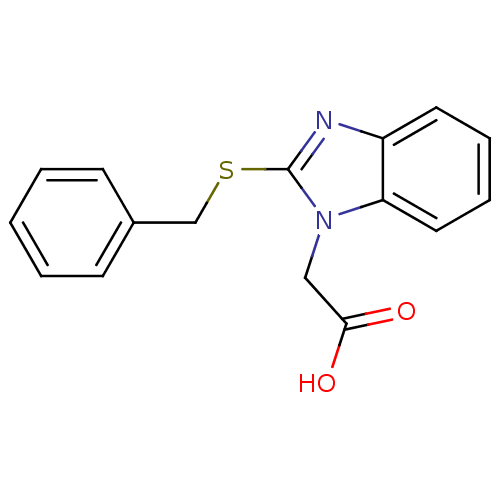

 Search and Browse
Search and Browse
 Download
Download
 Enter Data
Enter Data
BDBM50387244 CHEMBL1549031
SMILES: OC(=O)Cn1c(SCc2ccccc2)nc2ccccc12
InChI Key: InChIKey=MRSJYQOUPBHILP-UHFFFAOYSA-N
| Target/Host (Institution) | Ligand | Target/Host Links | Ligand Links | Trg + Lig Links | Ki nM | ΔG° kcal/mole | IC50 nM | Kd nM | EC50/IC50 nM | koff s-1 | kon M-1s-1 | pH | Temp °C |
|---|---|---|---|---|---|---|---|---|---|---|---|---|---|
| G protein-coupled receptor 44 (Homo sapiens (Human)) | BDBM50387244 (CHEMBL1549031) | PDB Reactome pathway KEGG UniProtKB/SwissProt DrugBank antibodypedia GoogleScholar AffyNet | Purchase CHEMBL PC cid PC sid UniChem Similars | Article PubMed | n/a | n/a | 388 | n/a | n/a | n/a | n/a | n/a | n/a |
Actelion Pharmaceuticals Ltd Curated by ChEMBL | Assay Description Displacement of [3H]-PGD2 from human CRTh2 receptor expressed in HEK293 cells | Bioorg Med Chem Lett 22: 4660-4 (2012) Article DOI: 10.1016/j.bmcl.2012.05.087 BindingDB Entry DOI: 10.7270/Q2M32WTH | |||||||||||
| More data for this Ligand-Target Pair | |||||||||||||
| 3-phosphoinositide dependent protein kinase-1 (Homo sapiens (Human)) | BDBM50387244 (CHEMBL1549031) | PDB MMDB NCI pathway Reactome pathway KEGG UniProtKB/SwissProt B.MOAD DrugBank antibodypedia GoogleScholar AffyNet | Purchase CHEMBL PC cid PC sid UniChem Similars | PubMed | n/a | n/a | n/a | >2.00E+5 | n/a | n/a | n/a | n/a | n/a |
Bioinformatics Institute (BII) Curated by ChEMBL | Assay Description Displacement of PIFtide from human PDK1 PIF pocket after 1 hr by fluorescence polarization assay | J Med Chem 58: 8285-91 (2015) BindingDB Entry DOI: 10.7270/Q2NS0WR2 | |||||||||||
| More data for this Ligand-Target Pair | |||||||||||||